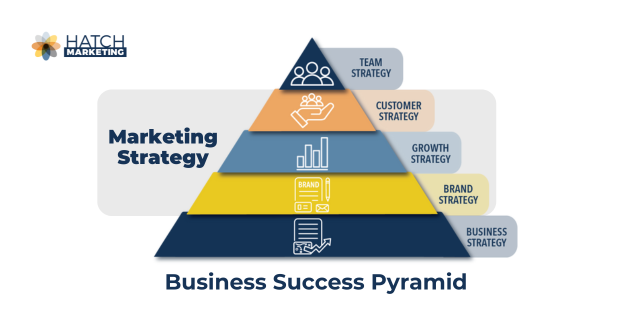What Is Marketing Strategy?
At its core, marketing strategy is a clear roadmap for how your business will grow, compete, and thrive. It’s not about scattered marketing tactics like ads or social media posts—it’s a comprehensive plan that aligns with your overarching business objectives to attract, retain, and delight your ideal customers.

The Business Success Pyramid offers a powerful framework that demonstrates how marketing strategy aligns with business objectives, ensuring every effort is purposeful and cohesive:
- Business Strategy: Aligning marketing goals with your overall business vision.
- Brand Strategy: Establishing who you are, who you serve, and what makes you unique.
- Growth Strategy: Attracting and converting the right customers.
- Customer Strategy: Retaining clients and turning them into advocates.
- Team Strategy: Ensuring your team executes the plan consistently.
By integrating all five levels, your business can create a seamless system that drives sustainable, measurable growth.
The Five Levels of the Business Growth Pyramid
1. Business Strategy: The Foundation for Everything
Before diving into marketing strategy, you need to start with your business strategy. This foundational level defines the big-picture goals your marketing efforts must support, such as:
- Achieving market dominance
- Increasing revenue and profitability
- Expanding into new markets
- Improving customer retention
Why It Matters: Marketing strategy isn’t separate from your business strategy—it exists to help you achieve your goals. By understanding your vision, profitability targets, and growth objectives, every marketing decision becomes intentional and aligned.
Example: If your business objective is to dominate a specific niche, your marketing strategy will focus on positioning your brand as the go-to expert in that space.
2. Brand Strategy: Define Your Identity and Promise
Your brand strategy defines how your business is perceived, who your ideal customers are, and how you uniquely solve their problems. It’s the foundation of trust and differentiation.
Key Elements of Brand Strategy:
- Ideal Customer Focus: Who are you serving? Narrowing your audience ensures your messaging resonates with the right people.
- Messaging and Positioning: Solve your customers’ biggest problems. Focus on why your business matters, not just what you sell.
- Brand Identity: Your tone, visuals, and overall personality reinforce your brand promise.
A clear brand strategy builds trust, loyalty, and recognition—laying the groundwork for every growth initiative.
Example: A fractional CMO agency might position itself as the strategic partner for purpose-driven businesses looking for sustainable growth.
3. Growth Strategy: Attract and Convert the Right Clients
The growth strategy focuses on how you’ll attract and convert prospects into customers. It involves specific tactics, tools, and campaigns to generate leads, nurture relationships, and drive conversions.
Key Elements of Growth Strategy:
- Lead Generation: Use SEO, content marketing, social media, and advertising to reach ideal customers.
- Content That Converts: Provide value through blogs, webinars, and guides to establish authority.
- Sales and Conversion Systems: Implement funnels, calls-to-action, and nurturing processes to turn leads into buyers.
Growth strategy ensures that every marketing effort—whether a Facebook ad, a webinar, or an SEO campaign—works toward generating measurable results.
Example: A sustainable home builder might use video case studies, SEO-optimized blogs, and LinkedIn ads to showcase their expertise and attract eco-conscious homeowners.
4. Customer Strategy: Delight and Retain Your Clients
The customer strategy ensures you’re delivering exceptional value after someone becomes a client. This level focuses on creating loyalty, retention, and referrals to maximize long-term success.
Key Elements of Customer Strategy:
- Seamless Onboarding: Make the first 90 days a wow experience to build trust and loyalty.
- Client Success: Keep customers engaged with ongoing communication, reporting, and value-added support.
- Referral Systems: Turn happy clients into advocates who generate new business through referrals.
Acquiring a new customer costs far more than retaining an existing one. A strong customer strategy increases lifetime value, reduces churn, and grows your business through word-of-mouth.
Example: A fractional CMO might provide monthly strategy reports and consistent check-ins to showcase progress and maintain client trust.
5. Team Strategy: Bringing It All Together
At the top of the Business Growth Pyramid is team strategy, which ensures your internal team delivers on the brand promise and marketing strategy. Even the best strategies fall flat without the right people, processes, and alignment.
Key Elements of Team Strategy:
- Training and Communication: Ensure everyone understands the business goals, brand positioning, and customer expectations.
- Empowered Execution: Equip your team with processes and tools to deliver consistent, high-quality results.
- Alignment Across Roles: Marketing, sales, and customer service teams must work together to create a seamless customer experience.
Team strategy bridges the gap between planning and execution, ensuring your brand promise is upheld at every touchpoint.
Example: A service firm might train its team to identify upsell opportunities and create processes for turning client feedback into actionable improvements.
How the Five Levels Work Together
The strength of the Business Growth Pyramid lies in its integration. Each level builds on the next, ensuring a comprehensive, aligned approach to growth:
- Business Strategy defines the goals your marketing efforts support.
- Brand Strategy establishes trust, messaging, and differentiation.
- Growth Strategy focuses on attracting and converting ideal customers.
- Customer Strategy ensures loyalty, retention, and referrals.
- Team Strategy empowers your team to execute consistently.
When all five levels align, your marketing strategy becomes a powerful engine that drives sustainable, measurable growth.
Strategy vs. Tactics: A Quick Comparison
Many businesses confuse strategy with tactics, but they serve different roles:
- Strategy: The big-picture plan that defines what you’re trying to achieve and why.
Example: “Position our brand as the leading expert for sustainable real estate.” - Tactics: The specific actions you take to implement the strategy.
Example: “Run LinkedIn ads, write blogs on eco-friendly design, and host webinars on sustainable living.”
Strategy gives you direction, while tactics are the tools to get there. Without strategy, tactics are scattered and aimless.
Key Takeaways: Build a Winning Marketing Strategy
To create a marketing strategy that delivers real results, focus on the five levels of the Business Growth Pyramid:
- Business Strategy: Align your marketing goals with your business vision.
- Brand Strategy: Define your identity, promise, and ideal customer.
- Growth Strategy: Use targeted tactics to attract and convert clients.
- Customer Strategy: Create exceptional experiences to retain customers and drive referrals.
- Team Strategy: Equip your team to deliver on your strategy seamlessly.
By integrating all five levels, you’ll create a marketing strategy that is aligned, measurable, and built for sustainable growth.
Ready to Transform Your Marketing?
At Hatch Marketing, we specialize in creating values-driven strategies that connect, convert, and empower brands like yours. Let’s build a Business Growth Pyramid that drives real, lasting success—together.
Let’s Talk Strategy Today!

